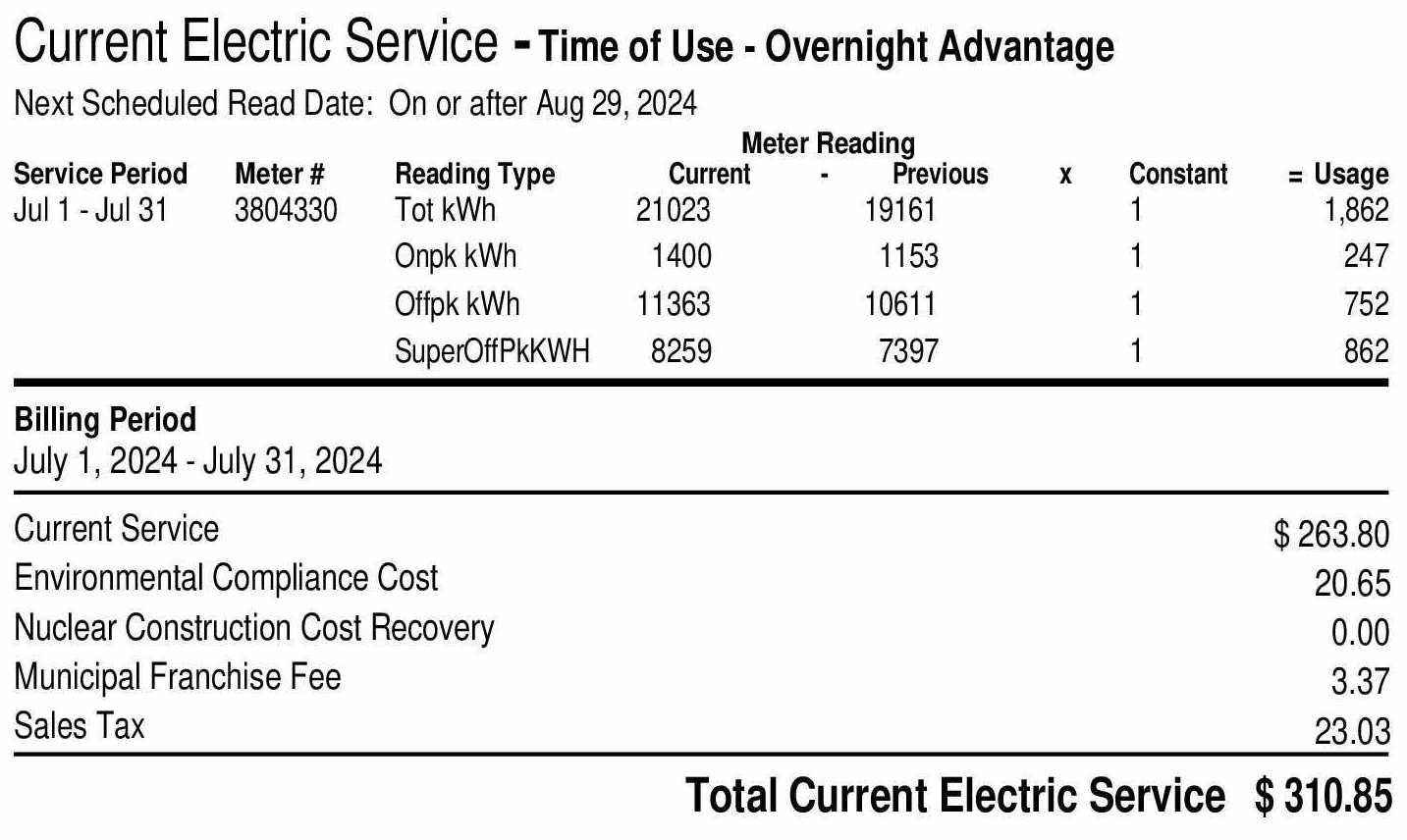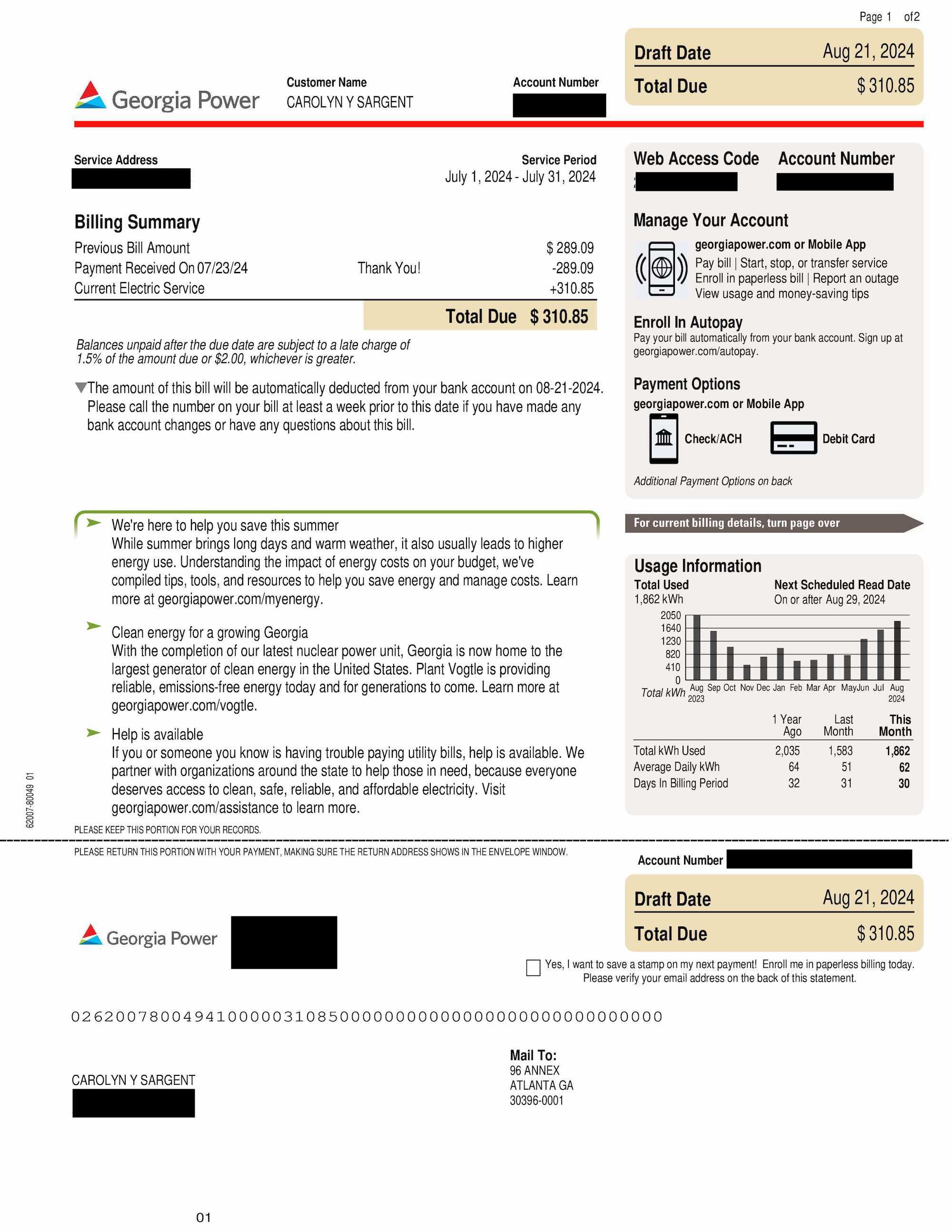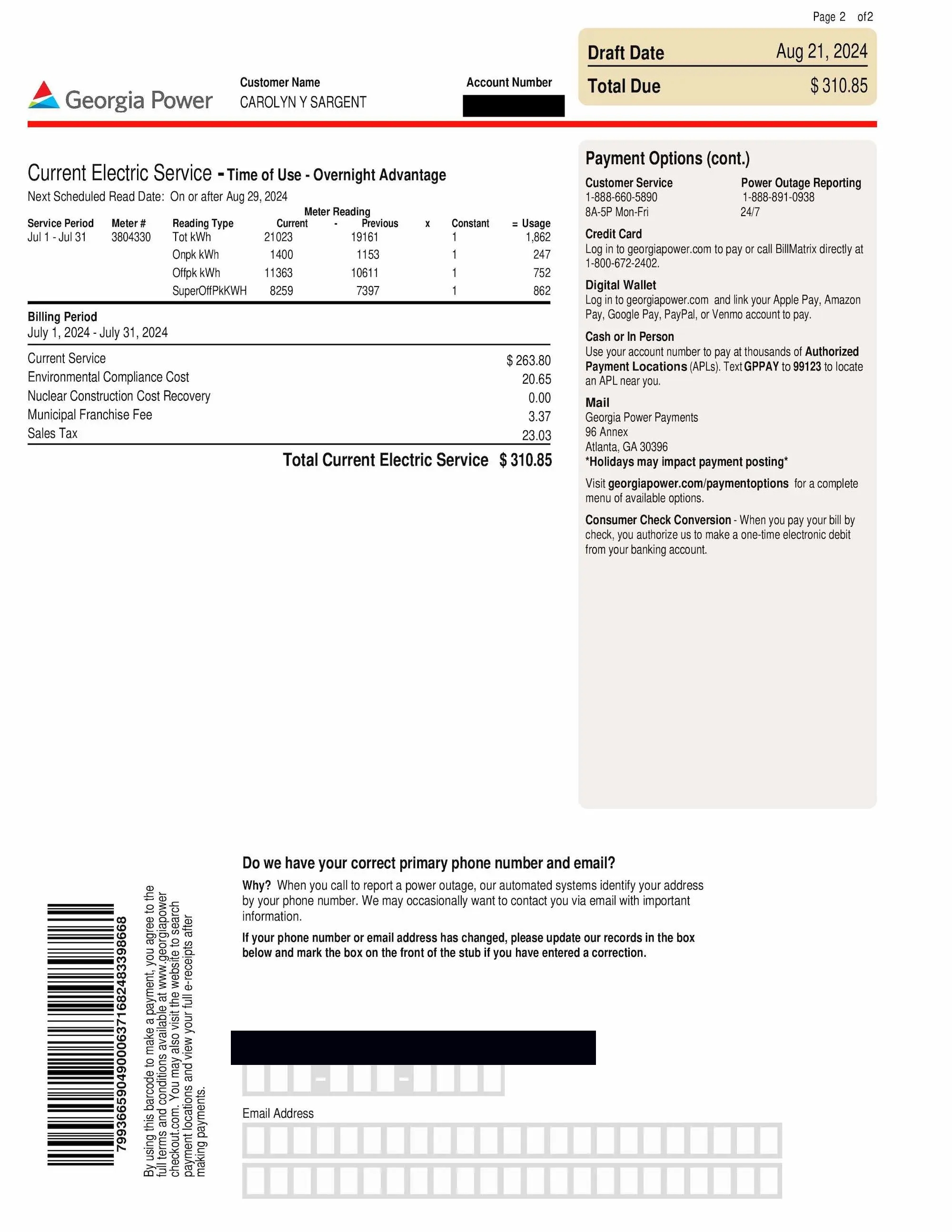Carolyn Yeago couldn’t figure it out. The Atlanta resident is a biomedical scientist, and no stranger to complex problems. But one thing she didn’t know how to calculate was her Georgia Power bill.
Yeago is on Georgia Power’s Overnight Advantage plan, designed for customers who, like her, own an electric vehicle or have other batteries to charge. It offers a lower rate between 11 p.m. and 7 a.m., incentivizing EV owners to plug their cars in when demand for electricity is otherwise low. In Georgia Power parlance, that period of time is “super off-peak.” There’s also “off-peak” (7 a.m to 2 p.m., then again from 7 p.m. to 11 p.m.) and “peak”— the height of the day, when electricity is most expensive. (Those three time periods apply only from June to September; the rest of the year, it’s just off-peak and super off-peak.)
A standard Georgia Power bill for residential customers lists a “current service” line, which is the main charge, reflecting electricity usage in the past billing period, followed by a few lines for various fees and sales tax. “Where I got totally confused is actually calculating your current service,” Yeago said. “What I had been doing is multiplying my usage hours by their rate number, from the rate plan, and adding that up. And it doesn’t equal your current service charge. It’s significantly less.”
The “current service” line doesn’t just reflect usage times rate, though. There’s also a “basic service charge,” billed as a fixed rate per day. So Yeago added that in. “And there’s still a discrepancy,” she said. Totaling it all up with the fees and tax, the number was lower than the one listed at the bottom of her bill — the one she had to pay.
Her concerns echoed others that readers have expressed to Grist, which is working on a project to demystify energy and electricity policy in Georgia. Through conversations with community members across metro Atlanta, in Rome, in Augusta, and in Macon, the most frequently asked question has been: How do I understand my power bill?
Here is a breakdown of all the charges, explicit and implicit, that make up a typical monthly electricity bill for Georgia residents.

RATE PLANS
Georgia Power offers seven different rate plans, including Overnight Advantage, FlatBill (a fixed monthly amount, averaged over 12 months), and Smart Usage (which incentivizes customers to keep demand down by, for instance, not running more than one major appliance within a given 60-minute period).
These are outliers, though. The vast majority of customers enroll in the Residential Service plan, in which kilowatt-hours rates change according to a schedule based on the time of year and — in the summer — how much electricity your household uses every month. (The first 650 kilowatt-hours, or kWh, are charged at a certain rate, and then the cost goes up in increments beyond that.) But, while Yeago’s Overnight Advantage plan differs a little in terms of how the kWh charges break down, the rest of this bill is the same as what you’ll find in other Residential Service plans. So if you’re a Georgia Power customer, your bill probably looks a lot like this one.
Here’s what’s on Carolyn Yeago’s bill:
Carolyn Yeago’s Georgia Power bill from July 2024
CURRENT SERVICE
As Yeago observed, there are two primary components to this line. One is the basic monthly charge — a flat rate of $0.4603 a day, covering costs of meter installation and maintenance — plus a charge based on household usage.
But the “current service” line also reflects other fees that aren’t specifically broken out on the bill — the source of Yeago’s confusion.
What else makes up current service?

FUEL CHARGE
This is a “rider” — an additional fee — that’s folded into the overall “current service” line on the monthly electricity bill, and not specifically broken out. Under law, Georgia Power is allowed to recover all costs it spends on fuel — coal, natural gas, uranium for nuclear energy, and so on. Natural gas makes up 48 percent of Georgia Power’s fuel mix. Since fuel costs, particularly natural gas, have risen in the past few years, so has this part of customers’ bills. The charge is billed per kilowatt-hour, with different rates at different times of the year: It costs more June through September (currently, 4.5876 cents per kWh) than it does October through May (4.2859 cents). Since this bill is from July, Yeago paid the higher rate; multiplied by her total usage of 1,862 kWh, this would have accounted for about $85 of her bill.
DEMAND SIDE MANAGEMENT SCHEDULE
This one covers administrative costs related to residential energy-efficiency programs. It’s assessed as a percentage of the base bill — that is, the basic service charge plus daily usage.

ENVIRONMENTAL COMPLIANCE COST
According to Georgia Power, this fee is to “recover capital costs and operating and maintenance costs associated with government mandated environmental costs.” In other words, it covers climate-friendly initiatives required by federal mandate, like scrubbers on coal plants; it also covers cleanup costs associated with coal ash, a byproduct of combustion. The Public Service Commission has allowed Georgia Power to pass the cost of coal ash cleanup, which it is required to do by law, to customers. Currently, the environmental compliance cost is calculated as just under 12 percent of the base bill; of that, according to the PSC, roughly 17 percent goes to coal ash cleanup.
NUCLEAR CONSTRUCTION COST RECOVERY
This was added to customers’ bills to help finance the construction of Units 3 and 4 at Plant Vogtle — the controversial nuclear power plant near Augusta. This charge appeared from 2011 to spring 2024 and on average added between $4 and $8 to the typical bill. Now that those units are in operation, the fee isn’t being collected anymore — which is why, despite the line item, there’s no actual charge on Yeago’s bill. The costs for Units 3 and 4 are now rolled into the current service charge.
MUNICIPAL FRANCHISE FEE
Franchise fees are what utilities pay to local governments for the use and maintenance of the public right-of-way, like roads and other public spaces. Depending on where they live, Georgia Power customers pay either an inside-city-limits fee or an outside-city-limits fee, with the former being a bit higher.
SALES TAX
Georgia’s standard 4 percent tax added to all retail sales, plus whatever local taxes apply; in this case, that means about another 7.4 percent.

Taking into account all of these various fees — particularly the ones embedded in the “current service” line — it became possible for Carolyn Yeago to get much closer to the total that showed up on her bill. One of the biggest surprises? The fuel charge. “When I googled ‘fuel recovery,’ all of the articles I found said something like, ‘It costs the average customer $15,’” she said. One of those articles was from early 2023, though, and fuel costs have since jumped repeatedly: 12 percent in June 2023 alone. Last year, the increased fuel charge added an extra $16 to an average customer’s bill. She knew that fuel was part of the bill, Yeago said. “I just didn’t realize how much higher it was.”
In spring 2024, those prices led some Georgia lawmakers to propose legislation requiring Georgia Power to offer specific information on fuel prices on customers’ bills, broken down by fuel type: coal, natural gas, nuclear, and solar. The company opposed the measure, saying its bills and its website already provide that type of data. Still, ratepayers like Yeago say that more information wouldn’t be a bad thing. “It’s such a challenge because I feel like if they’re going to offer all these different plans, they need to give the customer a way to determine which plan is best for them,” she said.
This was compiled with assistance from the Southface Institute, an Atlanta-based sustainability think tank with many resources on understanding utility payments.






